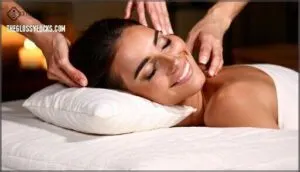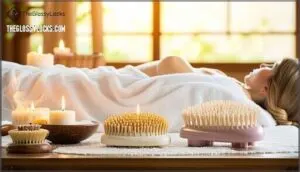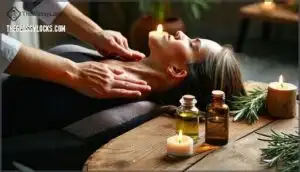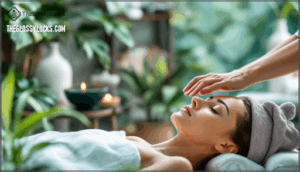This site is supported by our readers. We may earn a commission, at no cost to you, if you purchase through links.
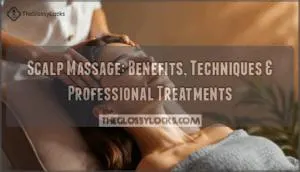
This simple practice activates dormant hair follicles, floods your scalp with nutrient-rich blood, and triggers a cascade of benefits that extend far beyond thicker strands. Research shows that consistent massage reduces tension headaches, lowers stress hormones linked to hair loss, and strengthens the foundation that healthy hair depends on.
Whether you’re dealing with thinning hair, chronic tension, or simply want to enhance what you’ve got, scalp massage offers measurable results without complicated routines or expensive products. Understanding the techniques and science behind this practice reveals why it’s become central to both traditional wellness and modern hair care.
Table Of Contents
- Key Takeaways
- Scalp Massage Benefits for Hair and Health
- How Scalp Massages Stimulate Hair Growth
- Effective Scalp Massage Techniques
- Scalp Massage Treatments and Professional Services
- Scalp Massage Market Trends and Research
- Frequently Asked Questions (FAQs)
- Are scalp massages safe?
- Can scalp massages be done on a daily basis?
- Are there any side effects associated with scalp massages?
- Is scalp massage safe for all hair types?
- How often should you massage your scalp?
- Can scalp massage reverse permanent hair loss?
- What age is scalp massage appropriate for?
- Do you need to use products during massage?
- Conclusion
Key Takeaways
- Just 4 minutes of daily scalp massage can increase hair thickness measurably over 24 weeks, with 69% of users reporting hair regrowth through mechanical stimulation that mimics pharmaceutical pathways.
- Scalp massage activates your parasympathetic nervous system, lowering cortisol and stress hormones that trigger hair loss while reducing chronic tension headaches from an average of 6.8 per week to 2.0 during treatment.
- The global scalp massager market is experiencing 80% growth, from $1.42 billion in 2024 to $2.58 billion by 2033, driven by rising consumer awareness of scalp health and growing demand for preventative hair restoration.
- You can build a sustainable routine by massaging 11–20 minutes daily with consistent pressure, incorporating it into your shower or self-care practice, though starting with two to three sessions weekly and adjusting based on your scalp’s response works best for most people.
Scalp Massage Benefits for Hair and Health
Scalp massage isn’t just about relaxation—it’s a simple practice that can transform your hair and overall health. From encouraging stronger, thicker strands to melting away tension that triggers headaches, the benefits reach far beyond what you might expect.
Scalp massage transforms your hair and health by strengthening strands and melting away tension that triggers headaches
Here’s what regular scalp massage can do for you.
Hair Growth and Thickness
Regular scalp massage can genuinely transform your hair’s appearance. A 2016 study showed that just 4 minutes daily increased hair thickness from 0.085 mm to 0.092 mm over 24 weeks.
Here’s what you’ll see:
- Follicle health improves through mechanical stretching that activates growth signals
- Thickness increase occurs as blood flow rises up to 25%, delivering nutrients directly to hair follicles
- Growth patterns stabilize—69% of users reported hair regrowth after consistent scalp stimulation
Your commitment matters: daily massage transmits mechanical forces that alter gene expression in hair follicle cells, mimicking pathways used by pharmaceutical treatments. Regular scalp massages can lead to improved hair growth benefits and are a great addition to your hair care routine.
Stress Relief and Relaxation
Beyond the visible changes to your hair, scalp massage works as a powerful stress reliever—lowering cortisol levels while activating your parasympathetic nervous system.
When you practice mindful massage, you’re engaging calming therapies that directly support mental wellness. This relaxation technique becomes more than self-care—it’s genuine stress management.
Regular massage therapy sessions stabilize your hormone levels, reduce blood pressure, and deliver immediate relaxation and wellness benefits that ripple through your entire body.
Headache and Migraine Reduction
Massage therapy for headaches delivers measurable pain management results—reducing chronic tension headaches from an average of 6.8 per week to just 2.0 during treatment. By targeting trigger points in the upper trapezius and sub-occipital muscles, individuals experience migraine relief through improved pressure-pain thresholds and headache prevention.
This scalp massage approach utilizes relaxation techniques and stress reduction to decrease both the intensity and duration of headaches. Some participants report 30% lower pain scores and a reduced need for medications.
Research endorses the use of massage for tension headache relief, highlighting its value as a complementary addition to treatment plans.
Improved Scalp and Skin Health
While tension relief starts at your temples, the real transformation happens at the scalp surface—where balanced oil production, improved circulation, and gentle exfoliation work together to support healthier skin and stronger hair follicles.
Scalp massage techniques promote skin renewal and sebum regulation, offering dermatological benefits that improve hair follicle health.
Regular scalp massage aids scalp health through natural exfoliation, creating ideal conditions for hair and scalp treatment outcomes.
How Scalp Massages Stimulate Hair Growth
Understanding how scalp massage works can help you get the most from your routine. The mechanical action triggers several biological responses that support hair health.
Here’s what happens beneath your fingertips when you massage your scalp.
Stretching and Activating Hair Follicles
When you apply consistent pressure during a scalp massage, you’re actually stretching the dermal papilla cells at the base of each hair follicle—a mechanical action that may trigger gene expression changes linked to hair growth.
This follicle stimulation creates scalp tension that encourages follicle activation and hair regeneration.
Regular massage therapy promotes scalp health through consistent follicle stimulation, making massage frequency a key factor in sustaining peak hair follicle function.
Increasing Blood Flow to The Scalp
Blood circulation surges when you apply massage therapy techniques, delivering oxygen-rich blood directly to each hair follicle. This scalp stimulation improves vascular health and bolsters scalp health by nourishing follicles with essential nutrients.
Enhanced blood flow from regular scalp massage creates an ideal environment for follicle function, strengthening the foundation for healthier hair growth and improved overall scalp condition.
Lowering Stress Hormones Linked to Hair Loss
Stress hormones, particularly cortisol, can quietly sabotage your hair follicles and trigger premature shedding across your scalp. Scalp massage provides effective stress relief by lowering cortisol levels and promoting hormone balance throughout your body.
This relaxation technique fosters hair regrowth by creating ideal conditions for scalp health, directly addressing stress-related hair loss. Regular massage sessions offer stress management that protects your follicles while encouraging natural hair growth through improved relaxation and reduced hormonal interference.
Effective Scalp Massage Techniques
You can perform scalp massage in several ways, each designed to suit your routine and preferences. The right technique depends on whether you want a quick session during your shower or a longer treatment with specialized tools.
Here’s how to approach each method effectively.
Traditional Finger Massage
Your fingertips are the most adaptable and accessible tools you have for scalp massage—no equipment needed, just a few minutes and the right technique. Start by applying light to moderate massage pressure across your scalp, moving your fingertips in small circular hand movements to boost scalp stimulation.
Here’s how proper finger techniques support scalp health:
- Position your fingers flat against your scalp and apply gentle massage pressure
- Move in slow circles, covering all areas from hairline to crown for complete scalp massage benefits
- Adjust massage techniques based on comfort, incorporating kneading motions for deeper massage therapy for hair
Massage While Washing Hair
Turn your daily shower into a hair-boosting ritual by combining scalp massage with shampooing—you’re already there, so why not make those suds work harder for you? Use your shampoo as a lubricant, letting your fingers glide smoothly across your scalp with gentle strokes that promote scalp exfoliation and hair growth.
Work the lather through your hair with circular massage techniques, focusing on scalp health while the hair oil and conditioner nourish each strand—it’s efficient hair care that fits seamlessly into your routine.
Using Brushes and Scalp Massagers
If your fingers could use a break—or you just want to step up the intensity—specialized brushes and scalp massagers deliver consistent pressure and deeper stimulation without wearing out your hands.
Choose from silicone brushes for gentle scalp exfoliation during shampooing, or electric massagers with adjustable settings that target specific areas for improved scalp health.
These tool materials—ranging from soft rubber to medical-grade silicone—let you customize your massage frequency and support hair growth through reliable, repeatable massage therapy.
Incorporating Essential Oils
Once you’ve found the right tool for your technique, adding essential oils takes your scalp massage to another level—turning a simple practice into a more potent ritual for hair growth and relaxation.
Peppermint and rosemary oils are your go-to choices for stimulating follicles and boosting circulation. Lavender calms inflammation while easing tension. Mix a few drops into your carrier oil, then apply during massage.
The aromatherapy benefits work alongside the physical stimulation—your scalp gets herbal infusions that support both growth and stress relief, making this a complete scalp oil massage experience.
Scalp Massage Treatments and Professional Services
If you’re looking to take your scalp care beyond at-home routines, professional treatments offer specialized techniques and targeted solutions customized to your specific concerns.
These services range from growth-focused therapies to treatments designed for particular scalp conditions. Here’s what’s available to you.
Signature and Jet Plasma Treatments
Sophisticated scalp treatments like Jet Plasma Therapy and Signature Scalp Treatment offer innovative solutions for hair regrowth and scalp rejuvenation.
Jet Plasma uses ionized gas to generate microcurrent, enhancing growth factor absorption and stimulating dermal papillae over 6–10 sessions. The Signature Scalp Treatment combines 18 dedicated steps—detoxification, cleansing, balancing, restoration—in 80–120 minutes, with 90% client rebooking rates.
Both treatments cost $80–$125 per session, delivering noticeable scalp health improvements and hair density increases within weeks. Red LED therapy and essential oil integration boost results, making these professional services ideal for those seeking thorough scalp health and wellness solutions beyond at-home massage.
Psoriasis and Scalp Care Maintenance
Sometimes the scalp needs more than relaxation—it needs healing, especially when conditions like psoriasis create inflammation, flaking, and discomfort that make traditional massage uncomfortable. A Psoriasis Scalp Treatment combines soothing and restorative steps designed to calm irritation while promoting scalp health without aggravating sensitive skin. This specialized service takes a gentler approach than standard treatments, working around affected areas and using calming ingredients to reduce inflammation and itching.
For ongoing scalp maintenance beyond treatment, the Scalp Care Maintenance Treatment offers a 60-minute session focused on keeping your scalp and hair at their best between professional services. This maintenance approach assists long-term scalp health and prevents issues from returning, making it an ideal follow-up to either jet plasma therapy or signature treatments.
Both services recognize that scalp health isn’t one-size-fits-all—some clients need targeted relief, while others need consistent upkeep to maintain the gains they’ve already made.
When psoriasis triggers flare-ups, your skin barrier becomes compromised. The Psoriasis Scalp Treatment tackles this directly through gentle cleansing that doesn’t strip or irritate. Instead of aggressive exfoliation, therapists use calming protocols customized to inflamed skin. Regular Scalp Care Maintenance prevents future flare-ups by maintaining barrier integrity and reducing scalp inflammation over time. Think of it as preventive medicine—catching small issues before they become major skin conditions requiring intervention.
Hair Analysis and Membership Packages
Getting a clear picture of your scalp’s specific needs can transform how you approach treatment, and that’s where professional hair analysis steps in to bridge the gap between guesswork and individual care.
A Hair Analysis Add On bundles a Root Solutions Hair Analysis with any scalp massage service, giving you detailed insights into your hair’s condition, growth patterns, and specific concerns. This data-driven approach lets your therapist tailor treatments precisely to your needs.
Scalp Membership packages offer monthly head spa sessions, making premium services accessible while building consistent care into your routine. These package deals combine affordability with commitment, securing you maintain scalp health year-round.
Service Precautions and Extension Guidelines
Not every scalp can manage the same treatment, and knowing when to pump the brakes is just as important as knowing when to go all in.
Skip scalp massage if you’ve got undiagnosed lumps, cuts, or skin damage—these are contraindications that need professional attention first. Tape-in extensions, K-tips, braids, and locs aren’t compatible with standard massage therapy due to hair damage risk and scalp accessibility issues. Weft extensions only qualify for our Extension Add On service with modified techniques.
Scalp sensitivity varies widely, so treatment modifications guarantee you get benefits of scalp massage without compromising hair growth or causing discomfort. Always consult your therapist about your specific needs.
Scalp Massage Market Trends and Research
The scalp massage industry is booming, and the numbers tell an interesting story about what people are investing in their hair and wellness routines. Whether you’re curious about market growth, the tools driving innovation, how often people actually stick with their massage practices, or why certain regions embrace this practice more than others, we’ve got the research to back it up.
Here’s what the data reveals.
Global Market Growth and Forecast
The scalp massager market is experiencing real momentum. In 2024, the global market hit $1.42 billion and is projected to reach $2.58 billion by 2033—that’s roughly 80% growth. Here’s what’s driving this surge:
- Rising consumer awareness of scalp health and its connection to hair restoration
- Increased stress and anxiety levels making wellness services more appealing
- Growing disposable incomes enabling investment in spa and hair growth treatments
- Asia Pacific leading with 38% market share, fueled by traditional wellness practices
The compound annual growth rate sits around 6.9% through 2033, with regional commercial use—salons, spas, wellness centers—projected to grow at 7.0% annually. Offline retail still dominates at 60.58% of sales, though online channels are expanding rapidly. This economic impact reflects a broader shift toward preventative hair restoration and professional scalp massage services.
Popular Massage Tools and Innovations
The technology behind scalp massage has come a long way from fingers alone—today’s tools range from simple brushes to advanced devices that blend vibration, heat, and smart features. Electric brushes and vibrating massagers deliver consistent, targeted stimulation to hair follicles. Scalp rollers offer manual precision for focused treatment areas. Automated tools with massage apps let you customize pressure and frequency to your needs.
These innovations—from basic manual devices to app-connected massagers—make signature scalp treatments and scalp facial treatments more accessible, whether you’re using them at home or in a professional setting with your massage therapist.
User Habits and Routine Adherence
How consistent are you with your massage routine? Most users massage for 11–20 minutes daily, and about a third maintain the habit for at least 10 months. Building scalp discipline into your hair care routine requires intentional habit formation. When you integrate massage into your existing self-care practice—whether during showers or dedicated stress relief sessions—you’re more likely to stick with it.
- Daily massage frequency ranges from 11–20 minutes for median users, with some committing 30+ minutes
- User engagement varies: 32.4% maintain routine adherence for 10+ months, showing sustained habit formation
- Massage and relaxation work best when incorporated into established routines, boosting long-term scalp massage compliance
Regional Preferences and Cultural Practices
Scalp massage rituals span continents, shaped by centuries of cultural wisdom. Asia Pacific leads the market at 35.25% share, where traditional practices like Chinese pressure-point therapy and Indian Shiroabhyanga (oil massage) drive consumer adoption. Korean and Japanese beauty philosophies emphasize comprehensive scalp care with app-connected devices.
North America integrates smart technology and celebrity endorsements, while European brands prioritize eco-friendly materials.
African communal grooming traditions and Latin American botanical ingredients reflect how regional variations adapt massage therapy to local hair types and preferences, creating a truly global wellness landscape.
Frequently Asked Questions (FAQs)
Are scalp massages safe?
In general, scalp massage is safe for most people. However, you should avoid massage if you have undiagnosed lumps, cuts, or skin damage on your scalp.
Consult your massage therapist or healthcare provider before starting regular treatments to rule out contraindications and guarantee proper injury prevention techniques.
Can scalp massages be done on a daily basis?
Daily massages sound excessive, but your scalp’s actually tougher than you think. You can massage daily with gentle pressure—most users do 11–20 minutes. Just listen to your scalp. Skip days if you notice irritation or sensitivity.
Consistency drives Hair Growth Cycle benefits: improved circulation, stress relief, and follicle activation. Start conservatively, build your Routine Consistency gradually. Your scalp adapts.
Are there any side effects associated with scalp massages?
Most people tolerate scalp massage well, but adverse effects can occur. Allergic reactions to oils or products may cause skin irritation and scalp sensitivity. Excessive massage pressure risks tension headaches rather than relief.
Those with undiagnosed lumps, cuts, or skin damage should avoid treatment. Consult a healthcare provider before starting regular massage therapy to guarantee safe relaxation.
Is scalp massage safe for all hair types?
Most hair types respond well to scalp massage, though individual sensitivity varies. Coily and textured hair may need gentler pressure to prevent breakage. Always start light—your scalp will guide you.
Those with cuts, lumps, or skin conditions should consult a professional first. Hair damage risk decreases with proper technique and appropriate massage oils suited to your hair texture.
How often should you massage your scalp?
Most people benefit from three to five scalp massage sessions weekly, each lasting 11–20 minutes. However, your ideal frequency depends on your hair regrowth goals and scalp health.
For stress relief and hair loss prevention, consistent weekly sessions work well. Start conservatively—two sessions weekly—then adjust based on results.
If you’re addressing specific concerns like thinning, aim for daily five-minute massage therapy sessions. Listen to your scalp; more isn’t always better.
Can scalp massage reverse permanent hair loss?
Permanent hair loss, like male pattern baldness, involves irreversible follicle miniaturization. While scalp massage stimulates blood flow and may support hair regrowth in cases of temporary loss, it can’t reverse genetically determined alopecia.
However, massage therapy combined with professional hair restoration methods offers the most promising outcomes for addressing hair loss comprehensively.
What age is scalp massage appropriate for?
Appropriate across all ages, massage offers diverse benefits. Infant massage promotes bonding and circulation, while pediatric massage fosters healthy development. Teenagers benefit from stress relief and hair growth stimulation during hormonal changes.
Adults enjoy relaxation and hair care maintenance, whereas elderly individuals experience gentle stress management and improved scalp health.
Always consult healthcare providers for infants or those with medical conditions.
Do you need to use products during massage?
Like a door hinge needs oil to swing freely, your scalp works best with some lubrication during massage. You don’t strictly need products—your natural oils work fine.
But massage creams, shampoo, or essential oils reduce friction, heighten relaxation, and boost aromatherapy benefits. Choose what feels right for you.
Conclusion
What if the path to stronger, healthier hair doesn’t require expensive treatments or complicated routines? Scalp massage proves it doesn’t.
By dedicating just minutes to this practice, you activate your body’s natural healing mechanisms—increased blood flow, reduced stress hormones, and stimulated follicles working in concert.
Whether you choose your fingers, a tool, or professional treatment, consistency matters more than complexity. Your scalp has been waiting for this attention. Give it what it deserves, and watch your hair—and your whole self—transform.
- https://pmc.ncbi.nlm.nih.gov/articles/PMC4740347/
- https://www.goodrx.com/well-being/alternative-treatments/scalp-massage-for-hair-growth
- https://www.clintonpt.com/2025/05/08/does-scalp-massage-help-hair-growth/
- https://perfecthairhealth.com/scalp-massages-androgenic-alopecia-study/
- https://www.mapleacupunctureandmassage.com/home/blog/the-science-backed-advantages-of-scalp-massage


